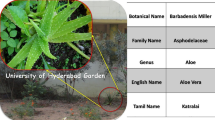Abstract
Mn(II), Co(II), Ni(II) and Cu(II) complexes having the general composition M(L)2X2 [where L = 2-pyridinecarboxaldehyde semicarbazone, M = Mn(II), Co(II), Ni(II) and Cu(II), X = Cl− and NO3 −] have been synthesized. All the synthesized compounds were identified and confirmed by elemental analysis, molar conductance, magnetic susceptibility measurements, mass, IR, EPR, electronic spectral studies and thermogravimetric analysis (TG). The Molar conductance measurements of the complexes lie in the range 209–228 Ω1 cm−1 mol−1 indicating that the complexes are 1:2 electrolytic in nature. Thus the complexes may be formulated as [M(L)2]X2. The magnetic moment measurements of the complexes indicate that all the complexes are in high-spin state. On the basis of spectral studies an octahedral geometry has been assigned for Mn(II), Co(II) and Ni(II) complexes whereas tetragonal geometry for Cu(II) complexes. The thermal studies suggested that the complexes are more stable compared with free ligand. This fact was supported by calculating the thermodynamic parameters by using Horowitz–Metzger (HM) and Coats–Redfern (CR) equations. The free ligand and its metal complexes were also evaluated against the growth of phytopathogenic fungi and bacteria in vitro.



Similar content being viewed by others
References
Mishra AK, Mishra SB, Manav N, Kaushik NK. Thermal and spectral studies of palladium(II) complexes. J Therm Anal Calorim. 2007;90:509–15.
Kasuga NC, Sekino K, Koumo C, Shimada N, Ishikawa M, Nomiya K. Synthesis, structural characterization and antimicrobial activities of 4- and 6-coordinate nickel(II) complexes with three thiosemicarbazones and semicarbazone ligands. J Inorg Biochem. 2001;84:55–65.
Cerecetto H, Di Maio R, González M, Risso M, Sagrera G, Seoane G, et al. Synthesis and antitrypanosomal evaluation of E-isomers of 5-nitro-2-furaldehyde and 5-nitrothiophene-2-carboxaldehyde semicarbazone derivatives. Structure–activity relationships. Eur J Med Chem. 2000;35:343–50.
Jacimovic ZK, Leovac VM, Giester G, Tomic ZD, Szecsenyi KM. Structural and thermal characterization of Fe(III) and Fe(II) complexes with tridentate ONO pyridoxal semicarbazone. J Therm Anal Calorim. 2007;90:549–55.
Dimmock JR, Sidhu KK, Tumber SD, Basran SK, Chen M, Quail JW, et al. Some aryl semicarbazones possessing anticonvulsant activities. Eur J Med Chem. 1995;30:287–301.
Dimmock JR, Vashishtha SC, Stables JP. Anticonvulsant properties of various acetylhydrazones, oxamoylhydrazones and semicarbazones derived from aromatic and unsaturated carbonyl compounds. Eur J Med Chem. 2000;35:241–8.
Ibrahim G, Khan MA, Bouet GM. Complexes of 2-furaldehyde 4-phenyl semicarbazone. Transit Met Chem. 2002;27:34–7.
Lee PF, Yang CT, Fan D, Vittal JJ, Ranford JD. Synthesis, characterization and physicochemical properties of copper(II) complexes containing salicylaldehyde semicarbazone. Polyhedron. 2003;22:2781–6.
Beraldo H, Nacif WF, West DX. Spectral studies of semicarbazones derived from 3- and 4-formylpyridine and 3- and 4-acetylpyridine: crystal and molecular structure of 3-formylpyridine semicarbazone. Spectrochim Acta. 2001;57A:1847–54.
Otero L, Aguirre G, Boiani L, Denicola A, Rigol C, Oleaazar C, et al. Nitrofurylsemicarbazone rhenium and ruthenium complexes as anti-trypanosomal agents. Eur J Med Chem. 2006;41:1231–9.
Chandra S, Gupta LK. Spectroscopic and biological studies on newly synthesized nickel(II) complexes of semicarbazones and thiosemicarbazones. Spectrochim Acta. 2005;62A:1089–94.
Chandra S, Kumar A. Spectral and physicochemical studies of Ni(II) complexes with some nitrogen–oxygen and nitrogen–sulphur donor ligands. J Indian Chem Soc. 2007;84:55–8.
Konstantinovic SS, Radovanovic BC, Krkljes A. Thermal behaviour of Co(II), Ni(II), Cu(II), Zn(II), Hg(II) and Pd(II) complexes with isatin-β-thiosemicarbazone. J Therm Anal Calorim. 2007;90:525–31.
Clark RJH, Williams CS. The far-infrared spectra of metal–halide complexes of pyridine and related ligands. Inorg Chem. 1965;4:350–7.
Bellamy LJ, Beecher LJ. The infra-red spectra of chelate compounds. Part I. Systems of keto-enol type. J Chem Soc. 1954;4487–90.
Nakamoto K. Infrared spectra of inorganic coordination compounds. 2nd ed. New York: Wiley-Interscience; 1970.
Lever ABP. Inorganic electronic spectroscopy. 1st ed. Amsterdam: Elsevier; 1968. p. 249–360.
Chandra S, Kumar A. Synthesis and physicochemical studies of Mn(II), Co(II), Ni(II) and Cu(II) complexes with 2-acetyl thiophene thiosemicarbazone (L). J Indian Chem Soc. 2007;84:325–8.
Chandra S, Gupta LK. EPR, mass, IR, electronic, and magnetic studies on copper(II) complexes of semicarbazones and thiosemicarbazones. Spectrochim Acta. 2005;61A:269–75.
Hathaway BJ, Bardley JN, Gillard RD. Essays in chemistry. New York: Academic Press; 1971. p. 61–72.
Burger K. Coordination chemistry: experimental methods. Budapest: Akademiai Kiado; 1973. p. 23.
Coats W, Redfern JP. Kinetic parameters from thermogravimetric data. Nature. 1964;201:68–9.
Prasad S, Agarwal RK. Cobalt(II) complexes of various thiosemicarbazones of 4-aminoantipyrine: syntheses, spectral, thermal and antimicrobial studies. Transit Met Chem. 2007;32:143–9.
Tang HA, Wang LF, Yang RD. Synthesis, characterization and antibacterial activities of manganese(II), cobalt(II), nickel(II), copper(II) and zinc(II) complexes with soluble vitamin K3 thiosemicarbazone. Transit Met Chem. 2003;28:395–8.
Acknowledgements
The authors are thankful to the DRDO, New Delhi for financial assistance and SAIF, IIT Bombay for recording EPR spectra.
Author information
Authors and Affiliations
Corresponding author
Rights and permissions
About this article
Cite this article
Refat, M.S., Chandra, S. & Tyagi, M. Spectroscopic, thermal and biocidal studies on Mn(II), Co(II), Ni(II) and Cu(II) complexes of tridentate ligand having semicarbazone moieties. J Therm Anal Calorim 100, 261–267 (2010). https://doi.org/10.1007/s10973-009-0397-5
Received:
Revised:
Accepted:
Published:
Issue Date:
DOI: https://doi.org/10.1007/s10973-009-0397-5




